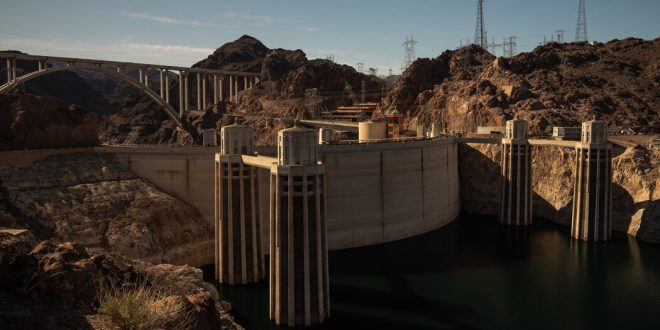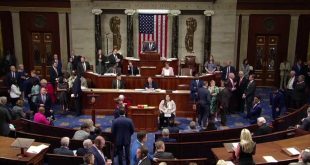WASHINGTON — After months of fruitless negotiations between the states that depend on the shrinking Colorado River, the Biden administration on Tuesday proposed to put aside legal precedent and save what’s left of the river by evenly cutting water allotments, reducing the water delivered to California, Arizona and Nevada by as much as one-quarter.
The size of those reductions and the prospect of the federal government unilaterally imposing them on states have never occurred in American history.
Overuse and a 23-year-long drought made worse by climate change have threatened to provoke a water and power catastrophe across the West. The Colorado River supplies drinking water to 40 million Americans as well as two states in Mexico, and irrigates 5.5 million agricultural acres. The electricity generated by dams on the river’s two main reservoirs, Lake Mead and Lake Powell, powers millions of homes and businesses.
But the river’s flows have recently fallen by one-third compared with historical averages. Levels in Lake Mead and Lake Powell are so low that water may soon fail to turn the turbines that generate electricity — and could even fall to the point that water is unable to reach the intake valves that control its flow out of the reservoirs. If that happened, the river would essentially stop moving.
The Biden administration is desperately trying to prevent that situation, known as deadpool. But it faces a political and ethical dilemma: How to divvy up the cuts required.
The Interior Department, which manages the river, released a draft analysis Tuesday that considered three options.
The first alternative was taking no action — a path that would risk deadpool. The other two options are making reductions based on the most senior water rights, or evenly distributing them across Arizona, California and Nevada, by reducing water deliveries by as much as 13 percent beyond what each state has already agreed to.
If changes were based on seniority of water rights, California, which among the seven states is the largest and oldest user of Colorado River water, would mostly be spared. But that would greatly harm Nevada and force disastrous reductions on Arizona: the aqueduct that carries drinking water to Phoenix and Tucson would be reduced almost to zero.
“Those are consequences that we would not allow to happen,” Tommy Beaudreau, the deputy secretary for the Interior Department, said in an interview on Monday.
Water Shortages in the United States
The consequences of climate change and aging infrastructure are increasingly being felt across America.
Arizona and Nevada are both important swing states for President Biden, if he decides to run again next year. Both states also have Senate seats valuable to Democrats that will be on the ballot in 2024.
Chuck Coughlin, a political consultant who worked for former Republican governor Jan Brewer, said that if the Biden administration limits the pain imposed on Arizona, he had “no doubt” it would benefit Mr. Biden politically.
Another challenge with letting the cuts fall disproportionately on Arizona: Doing so would hurt the Native American tribes that rely on that water, and whose rights to it are guaranteed by treaty. Governor Stephen Roe Lewis of the Gila River Indian Community, which is entitled to a significant share of Colorado River water, said the goal should be “a consensual approach that we can all live with.”
Spreading the reductions evenly would reduce the impact on tribes in Arizona, and also help protect the state’s fast-growing cities. But it would hurt Southern California’s agriculture industry, which helps feed the nation, as well as invite lawsuits. The longstanding legal precedent, often called the law of the river, has been to allocate water based on seniority of water rights.
The draft analysis did not formally endorse any option; a final analysis is expected this summer, and it could include still other approaches.
But Mr. Beaudreau said he was “pretty comfortable” that allocating cuts evenly would let the department meet its goals — preventing water levels in Lake Mead and Lake Powell from falling below critical levels, protecting health and safety, and not exceeding the department’s legal authority.
He defended the government’s willingness to depart from longstanding seniority rules about water rights, arguing that the shocks of climate change couldn’t have been predicted when those rights were agreed to decades ago.
The proposal marks a new and painful phase in America’s efforts to adapt to the decades-long drought in the West. Until now, the federal government has responded to drought primarily by paying farmers, cities and Native tribes to voluntarily use less water.
The Interior Department has accelerated that approach, providing hundreds of millions of dollars for water conservation along the Colorado. But it’s unlikely to be enough.
Mr. Beaudreau said he would rather that the states that rely on the Colorado reach an agreement among themselves, so that the federal government doesn’t have to impose reductions. In addition to Arizona, California and Nevada — the so-called lower basin states, which get their Colorado River water primarily from Lake Mead — that group includes Colorado, New Mexico, Utah and Wyoming, which draw water directly from the river system.
The federal government has the ability to impose cuts only on the lower-basin states that rely on water released from Lake Mead and Lake Powell. As a result, the draft analysis is focused on how to distribute cuts among those three states.
At a news conference to announce the results of the assessment, Tom Buschatzke, Arizona’s lead negotiator in the Colorado River talks endorsed the idea of cutting each state’s share equally. He said Arizona has long sought what he called “an equitable outcome.”
John Entsminger, the lead negotiator for Nevada, said that while he was still reviewing the report, his state was also generally in favor of an equitable approach to reductions.
He agreed with the Interior Department’s assertion that making water cuts primarily by seniority may no longer make sense in a time of climate change.
“We have 19th century laws, we have 20th century infrastructure, and we have 21st century climate,” Mr. Entsminger said in an interview. “And those three things don’t fit very well together.”
The Metropolitan Water District of Southern California, one of the largest users of Colorado River water, said it was concerned that the options examined by the federal government would result in painful cuts.
The draft proposal “is a powerful indication of what could come if we don’t reach a consensus,” Adel Hagekhalil, the district’s general manager, said in a statement.
Still, recent experience has shown that getting states to agree to an alternative system of cuts is a tall order.
Last summer, the water level in Lake Mead sank to its lowest ever. The department gave states two months to agree on a plan for reducing their use of Colorado River water by about 20 to 40 percent of the river’s entire flow. The states failed to agree; the federal government took no action.
Last fall, the department again asked the states to come up with a plan. In January, six of the states — all but California — reached an agreement: They proposed that the bulk of the cuts come from California.
California, in response, offered its own plan: The bulk of the cuts should come from Arizona.
Since then, the states have continued negotiating, without reaching a deal. The Interior Department made clear on Tuesday that it would still welcome an agreement among the states, which it could study in the final assessment due out this summer.
Two things may have increased the odds of states reaching an agreement, according to Sharon Megdal, director of the University of Arizona’s Water Resources Research Center.
First, an unusually wet winter has reduced the scale of the cuts required to avoid deadpool. But Dr. Megdal stressed that a reprieve is only temporary; one more bad winter “could put us back in really serious jeopardy.”
The second reason a deal among the states may now be within reach, Dr. Megdal said, is that after months of talking, the federal government finally appears ready to act.
“They’re showing that they will tell the states what to do,” she said. “It will now be up to the states to say, well, we have a better idea — and here it is.”
 Top Naija News: Nigerian News, Breaking News Nigeria and World News Top Naija News is a daily news publication in Nigeria, delivering the latest breaking news in Nigeria and around the world.
Top Naija News: Nigerian News, Breaking News Nigeria and World News Top Naija News is a daily news publication in Nigeria, delivering the latest breaking news in Nigeria and around the world.




